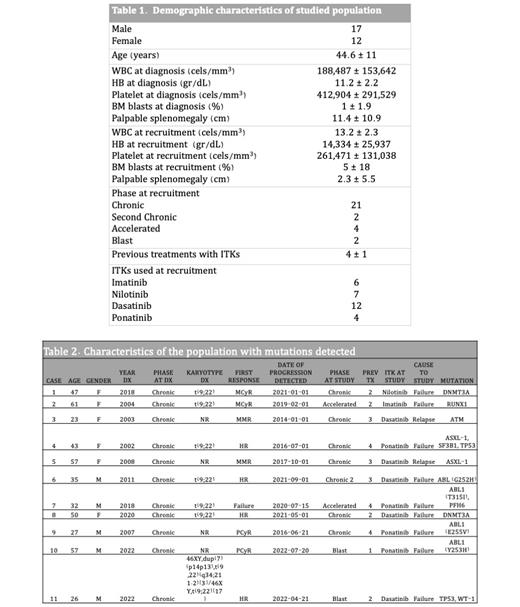Introduction: Even in the tyrosine kinase inhibitors (TKIs) era, there's still a subgroup of patients with chronic myeloid leukemia (CML) with poor response to treatment and therefore worse prognosis. The most frequent cause of resistance to treatment is the mutation in ABL fusion protein reported in 15-25% of the failures to TKIs. Nevertheless, there are other several factors not clearly described yet in published data, including myeloid mutations assessed by Next-Generation Sequence (NGS) beyond BCR-ABL kinase domain mutations.
Methods: We performed a multicenter, open, prospective trial to identify the frequency and clinical implications of myeloid mutations. We included all patients with relapsed/refractory CML to any TKI defined as failure to achieve cytogenetic response at 3 months or decrease <10% of BCR/ABL at 6 months or progression of CML after any response achieved by TKI. Patients with intolerance or non-adherence to treatment were excluded. For adherence validation, the MMAS-8 test was applied. We calculated a sample of 29 patients. Recruitment began in February 2021 and the sample was completed in August 2022. DNA was extracted from a bone marrow blood in EDTA with the automatized equipment, Maxwell 16 DNA purification Kits. The evaluation of DNA was performed by massive parallel sequencing of 40 genes frequently mutated in myeloid malignancies identifying ABL mutations and simultaneous mutations in other genes.
Results: Twenty-nine patients were evaluated in 16 centers from February 2021 to August 2022; seventeen were men. Six patients were diagnosed from 2002 to 2009, seventeen from 2010 to2019 and 6 after 2020. At time of diagnosis, the mean age was 45 years ± 14.8, two were in accelerated phase (AP-CML) and the rest were diagnosed in chronic phase (CP-CML). Sokal score was achievable in 24 cases being low, intermediate and high in 6, 15 and 3 cases respectively. In karyotype, two patients showed minor chromosomal aberrations and another one had complex karyotype. The study was performed at 68.1 months from diagnosis; 9 cases had relapse and the rest didn't achieve molecular responses. All the treatment failures were identified by PCR-BCR/ABL by the exception of two cases that presented blast phase (BP-CML). At recruitment, 23 cases were in CP-CML (2 in its second), 4 cases in AP-CML and 2 in BP-CML. The patients had a mean of 4 previous lines of treatment. The NGS panel showed the next results:
Sixteen mutations were found in eleven patients (37.9%).
As expected the most frequently mutated gene was ABL in four cases. The mutations involved were G252H, T315I, E255V, Y253H.
Nevertheless, there were more patients with mutations in genes other than ABL with seven cases.
Three mutations were repeated in two occasions: DNMT3A, ASXL-1 y TP53.
The other mutations detected were RUNX1, ATM, PFH6, SF3B1, y WT1.
Patients with mutations detected had higher Sokal score compared to non-mutated ones, 0.96 vs 1.05 points, without statistical significance.
The only variable that showed statistical value for the presence or absence of mutations was the platelet count at diagnosis (281,200 vs 478,523)
Conclusion: This study shows us that there are more mutations associated with therapeutic failure in patients with CML in addition to those in the ABL domain. Knowing these mutations can support the diagnosis, prognosis, establish target therapies and even guide the decision of a bone marrow transplant. Studies with larger populations are required to corroborate the data presented here to generate correlations the clinical and prognostic relevance of myeloid mutations, both at the time of treatment failure and perhaps at diagnosis.
Disclosures
Ovilla-Martínez:Janssen: Speakers Bureau; Roche: Speakers Bureau. Baez Islas:Brystol: Speakers Bureau.


This feature is available to Subscribers Only
Sign In or Create an Account Close Modal